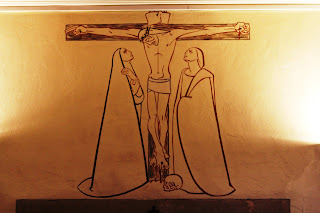In my guest room at Prinknash Abbey I found a delightful old book entitled "The Benedictine
Oblate’s Manual", edited by ‘a monk of Prinknash Priory’ and published with an
Imprimatur and Nihil Obstat in 1928. The following is taken directly from it with kind permission.
The first official approval of the Cross or Medal of St
Benedict was that given by Pope Benedict XIV on March 12th 1742 who
issued an Apostolic Brief recalling the general doctrine of sacramentals and
the history of the Cross of St Benedict, prescribing the form of blessing to be
applied to the Cross, and enriching it with indulgences.
Like so many pious practices approved by Holy Church, the
Cross of Saint Benedict had a fortuitous origin, which of itself suggested the
form and manner of its development by the faithful.
The known facts are these:
The
town and countryside of Bavaria had been, for some time, a prey to those
“venomous serpents”, the witches and sorcerers, so numerous in Europe during
the period of social unrest and disorder following on from the so called
Reformation, when the natural bent of men to superstition received a fillip
from the general loosening of devotional and moral discipline. Sorcery had become so common that the civil
authorities felt themselves obliged to make new laws, with very severe
sanctions, under which numbers of wretched men and women were arrested,
tortured and put to death. In the course
of their compulsory confessions, many of these unhappy victims of needless
cruelty made known their utter failure of their spells in (the) presence of the
Cross of Christ and particularly in the vicinity of the Monastery of Metten. *
Struck with the frequency of this admission on the part of
their prisoners, the magistrates instituted and enquiry at the Monastery; as so
discovered numerous crosses, painted on the walls of the Church and cloister,
all signed with certain mysterious letters.
Further research brought to light a precious illuminated manuscript of
the four Gospels, followed by certain mystical treatises, the last of which was
the famous one of the Holy Cross, by Blessed Rabanus Maurus. There the skilled scribe had drawn a splendid
figure of Saint Benedict, clad in the monastic cowl and bearing in his right
hand a cross and, in his left, a scroll, on both of which were written the
words whose initials appeared on and around the crosses of the wall
paintings. This manuscript is dated 1415
AD, in the reign of Abbot Peter of Metten.
Whether the scribe himself composed these inscriptions, or
merely recorded in them a tradition of some iniquity, in the year 1647, the
pious use of crosses or medals, inscribed with the letters found at Metten,
became common among the people of the district, and sorcery entirely
disappeared. And, so beneficial were the
practices suggested by the piety of the faithful in the use of this cross, that
the monks applied to the Holy See for an approval of this devotion and
faculties to bless medals stamped with the Cross and the letters mentioned
above.
Amongst the earliest to use and propagate the Cross of St.
Benedict was the great religious founder St. Vincent de Paul. “Monsieur
Vincent” as he was affectionately called by all the people of his day,
distributed the medal of Saint Benedict, as soon as it was obtainable, to all
his nursing Sisters, the Daughters of Charity, bidding them use it in attending
the sick. This they did, and with the
best of results. Not only were wounds
healed and diseases cured with remarkable ease, but the hardened sinners were
moved to repentance and reconciled to God; and the dying were comforted in
their agony. The Sisters have, ever
since, worn such medals attached to their Rosary beads. Many prodigies have been recorded throughout
the world, but especially in the Foreign Missions, showing the wonderful
effects of the pious use of the Cross of Saint Benedict.
*Out of which came
in 1846, Dom Boniface Wimmer, founder of the American Cassinese Congregation.
Two Special Uses of the Medal
By a rescript of the Sacred Congregation of Religious (4 May 1965) lay Oblates of St. Benedict are permitted to wear the Medal of St. Benedict instead of the small black cloth scapular formerly worn.
By a decree of the Sacred Congregation of Rites (6 March 1959), the Blessing of St. Maur over the sick is permitted to be given with a Medal of St. Benedict instead of with a relic of the True Cross, since the latter is difficult to obtain.
In the next post I shall describe the wording and their meanings found on the Jubilee Medal.


